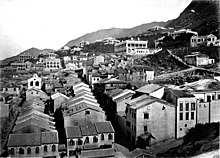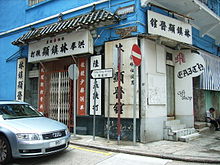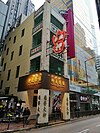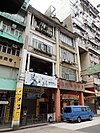Tong lau
| Tong lau | |||||||||
|---|---|---|---|---|---|---|---|---|---|
 A structural drawing of a tong lau. Illustrated by O. Chadwick, 1882. | |||||||||
| Traditional Chinese | Đường lâu | ||||||||
| |||||||||
| Ke lau | |||||||||
| Traditional Chinese | Kỵ lâu | ||||||||
| |||||||||

Tong lauorke lauaretenement buildingsbuilt from the late 19th century to the 1960s inHong Kong,Taiwan,Southern China,andSoutheast Asia.Designed for both residential and commercial uses, they are similar in style and function to theshophouseswithfive-foot way(Min Nan Chinese:têng-á-kha) of Southeast Asia. Over the years, tong lau construction has seen influences ofEdwardian-style architecture and later theBauhaus movement.
Etymology[edit]
Tong lau(Cantonese) ortang lou(Mandarin) means "Chinese building" –TongorTang(Đường) refers to theTang dynastyand is used as a term to mean Chinese, andlau(Lâu) is a building with more than one floor. It is a general term for a type of building found in Hong Kong that also developed inMacauandCanton(Guangzhou) from traditional Southern Chinese townhouses.
Architecture[edit]

Early tong lau buildings were generally long and narrow with a width of between 12 and 15 feet (3.7 and 4.6 m), determined by the length of the wooden beams.[1]In Hong Kong's building regulations,tong laurefers to a building with any living space intended for more than one tenant.[2]It is essentially a tenement building for residential and commercial use. The ground floor is reserved for commercial use, mostly by small businesses like retail shops and food vendors. The upper floors are for residential use, and cater to Chinese residents of Hong Kong.
Most early tong lau were two-to-four stories tall, due to building regulations that initially limited the height of building to 1.25 times the width of the street with a maximum height of 35 feet (11 m). However, due to the influx of migrants from mainland China to Hong Kong in the 1950s, height control of buildings was relaxed in 1955, and some tong lau that were built after that might have nine or more floors and be built withoutlifts.[3]The heyday oftong lauended in the 1960s when population pressure resulted in many tong lau being demolished to make way for high-rise buildings, along with changes in building ordinances in order to allow for such high-rise buildings.[4]
Ke lauorqilou(Chinese:Kỵ lâu.meaning "riding building" ), is a form of tong lau with an arcade running alongside the road for pedestrian use. The term was originally "kelauwith feet "(Chinese:Hữu cước kỵ lâu;pinyin:youjiao qilou;Jyutping:Jau5goek3 Ke4lau2), which was first used in Canton's building regulations in 1912, and referred to the columns forming the colonnade that supported the projecting floors that "ride" above. The ke lau buildings developed in Guangzhou were influenced by local traditions and the shophouses withfive-foot waysofSingapore,which were first built following the instructions ofStamford Rafflesgiven in histown plansoon after the founding of the colony in the early 19th century. Ke lau were built in Southern China (Guangdong,GuangxiandFujian) starting in the early 20th century. Most of the ke lau in Guangzhou were built in the 1930s until the outbreak of theSino-Japanese war,and few were built after that period.[5]
History[edit]
Earlytong lau[edit]

Early Hong Kongese tong lau mainly consisted of two- or three-story structures built back-to-back in areas such as Tai Ping Shan. 19th-century tong lau synthesizedChineseand European architectural features. While the Chinese component was based on building design from southern China, mainly that ofGuangdongProvince; European influences were usuallyNeoclassical.The tong lau roof used wood and/orXieding tilesand iron was used for the balconies. The balcony's design was based on Cantonese styles. Windows used French styling and were made of wood and glass. The upper floors were supported by brick pillars and protruded out to the edge of the street.[citation needed]
Inside, the floors were connected by wooden stairs. Most floors ranged from 450 to 700 square feet with very high ceilings. Top floors were often living quarters for shopkeepers and their family.
Other architectural features of early tong lau are:[citation needed]
- granitecappedbalustrades
- decorativeurnson the roof
- wooden floors and joists
- Canton floor tiles

In 1903, in response to an outbreak ofbubonic plague,the Hong Kong government issued a set of new regulations for tong lau so as to improve the living conditions for inhabitants in these buildings. Newtong laubuildings needed to have a light well, have larger windows, and the buildings were limited to four floors so their residents can receive sufficient light. The frontage were set at 15 feet, and at the back there needed to be a six-foot lane, so as to remove back-to-back constructions. Roof tiles were also replaced by flat concrete roofs.[6]
In the 1920s,reinforced concretebegan to be introduced as the main structural element, which allowed for averandaas well ascantileveredor recessed balconies to let in extra light.[6]An example of tong lau or ke lau from this period isLui Seng Chun,a building in reinforced concrete built in Hong Kong in 1931.[7]
After World War II[edit]


Tong lau built after World War II were simpler in design:
Iron balconies were replaced with concrete ones and later sealed with windows. Roofs were often flat with an open terrace and later renovated to allow for additional residential space. Wooden windows gave way to stainless steel windows. Air conditioning units were added to the windows in the 1970s and 1980s. Often clothes racks were added below the windows and hung above the sidewalk or street below. Signs were hung on the exterior walls and protruded onto the streets below.[citation needed]
Other features of the new tong lau included:[citation needed]
- mosaic floor tiles
- terrazzostaircase
Thepostwar boomand influx of immigrants led to a shortage of housing in Hong Kong. Many tong lau were renovated to become rental units. In order to become spacious space, each unit was separated from adjacent units through brick party walls, is between 13 and 16 feet wide (about 4 to 5 m).[8]
The ground floor of a tong lau was used as shop space, but a cockloft was often built on the upper space in front of the partition wall of the kitchen, or utilized as working area. Rooms on the upper floors were divided into smaller rooms and sublet as units by owners; said rooms were only big enough to accommodate bunk beds. The middle of the floor was a common space for tenants to eat and use. Bathrooms and kitchens were also shared among the tenants of each floor. Tenants paid for electricity and water on a monthly basis.[8]
The subletting of floors in tong lau led to changes in housing regulations in Hong Kong.
After the 1960s, many tong lau were demolished to give way to taller apartment and commercial buildings, especially new town or private apartment. Fewer Tong Lau are relatively found in Hong Kong today.[9]
On 29 January 2010, No. 45J Ma Tau Wai Road,Ma Tau Wai,a five-story-tall tong lau of more than 50 years history, suddenly collapsed at approximately 1:43 pm. Four people were killed. Such spontaneous, cascading and complete building collapse in Hong Kong has been quite rare since the Second World War and the incident raised concern of theHKSAR Governmentand the Hong Kong public towards the safety of the agingtong lauin Hong Kong, especially those built with similar specifications 50 or more years ago.[10]
Location[edit]
Mainland China[edit]



Ke lau styles varied from Chinese to European:[citation needed]
- Gothic Style
- Nanyang (Southeast Asia) Style
- Ancient Roman Gallery Style
- Imitation Baroque Style
- Modernisme
- Traditional Chinese Architectural Style
Guangdong[edit]
Southern China, namely cities inGuangdongProvince, is the birthplace of tong lau and ke lau. They were built by wealthy Chinese merchants in the cities likeGuangzhouand, with the aid ofoverseas Chinese,inemigrantmarket towns likeChikan, Kaiping.[11]
Locations inGuangzhouwithKe lau:
- Renmin Zhong Road ( nhân dân trung lộ )
- Renmin Nan Road ( nhân dân nam lộ )
- Shangxiajiu Pedestrian Street,including Dishifu Road ( thượng hạ cửu bộ hành nhai )
- Yide Road especially area around theSacred Heart Stone House Cathedral( nhất đức lộ )
- Wanfu Road ( vạn phúc lộ )
- Taikang Road ( thái khang lộ )
- Xinhua Bookstore of Science and Technology on Beijing Road ( bắc kinh lộ )
- Oi Kwan Hotelon Yanjiangxi Road ( duyên giang tây lộ )
- 186 Wenming Road ( văn minh lộ )
- 139 Dezheng Nan Road ( đức chính nam lộ )
Hainan and Guangxi[edit]
As bothHainan Islandand the eastern part of theGuangxi Provincelie in the broaderCantonesesphere of linguistical and cultural influence and historically were part ofGuangdong,several cities and towns also have this kind of architecture.
Beihai[edit]
The city ofBeihailies on the coast inGuangxi.The Old Sheng Ping Street (Thăng bình nhai cựu chỉ) is lined with 'ke lau architecture. Life and trade thrived here in the 19th century. Today it is full of restaurants, souvenir shops and adorned with sculptures and boards with information about local culture.
Haikou[edit]
The historicalBo'ai Road areais located in the heart of theHainancapital city ofHaikou.Nearly all the buildings here are of tong lau style. Beginning in 2012, the entire area has been undergoing restoration. It started withZhongshan Road,now completed and converted into apedestrian zone.The restoration is currently expanding outward with the facades being replastered and painted. Lights facing toward the facades to illuminate them at night are now installed on many of the buildings. With road repair ongoing, and new, tourist-related businesses replacing the old shops, the entire area is being developed as a visitor attraction.[citation needed]
Chengmai[edit]
The southern part of the town of Chengmai, located inChengmai County,Hainan, has an area adjacent to theNandu Riverthat consists of numerous, dilapidated tong lau buildings.[citation needed]
Wenchang[edit]
The tong lau buildings in the city ofWenchang's "Wennan Old Street" have been completely restored. Unlike Haikou's Bo'ai Road area, the facades are unpainted and are gray in appearance. The area is located downtown and is a visitor attraction.[citation needed]
Puqian[edit]
An area within the town ofPuqian,mostly consisting of a single street, is lined with tong lau buildings. This street is the main route from the port to thecity center.However, the tong lau buildings here are in serious disrepair. In fact, many of them are structurally unsafe.[citation needed]
Macau[edit]

Tong lau are also found inMacauonAvenida de Almeida Ribeironear theLargo do Senado.They are better preserved in Macau, where they did not give way to newer buildings. Upper floors no longer house people and often are assigned for commercial use. Tong lau here often featurePortuguesecolonial architectural influences.[citation needed]
Hong Kong[edit]
The existence of tong lau was a culmination of a series of historic forces including the economic development of Hong Kong, the Second World War, and the influx of Chinese migrants to Hong Kong.[12]
In 1898, the government introduced a building and public health ordinance which defined all the buildings including tong lau. In 1903, the government introduced a four-story limit as well as a maximum height per story of 9 feet (2.7 m). This explains the general appearance of tong lau. The ordinance changed in 1962; this became fully operative in 1966, and no tong lau was built later.[13]
Tong lausare mainly distributed in the following areas in Hong Kong:Cheung Chau,[14]Kennedy Town,[15]Shek Tong Tsui,[16]Sai Ying Pun,[17]Sheung Wan,[18]Central,[19]Wan Chai,[20]Causeway Bay,[21]Happy Valley,[22]Tai Hang,[23]North Point,[24]Quarry Bay,[25]Sai Wan Ho,[26]Shau Kei Wan,[27]Chai Wan,Aberdeen,[28]Tin Wan,[29]Ap Lei Chau,[30]Stanley,[31]Tsim Sha Tsui,[32]Yau Ma Tei,[33]Mong Kok,[34]Tai Kok Tsui,[35]Sham Shui Po,[36]Cheung Sha Wan,[37]Shek Kip Mei,[38]Hung Hom,[39]To Kwa Wan,[40]Ma Tau Wai,[41]Ho Man Tin,[42]Kowloon City,[43]Wong Tai Sin,[44]San Po Kong,[45]Lok Fu,[46]Tsz Wan Shan,[47]Ngau Chi Wan,[48]Kwun Tong,[49]Ngau Tau Kok,[50]Cha Kwo Ling,[51]Kwai Chung,[52]Tsuen Wan,[53]Tuen Mun,[54]Yuen Long,[55]Tai Wai,[56]Tai Po,[57]Luen Wo Hui,[51]Sheung Shui,[58]Sha Tau Kok,[51]Sai Kung Town,[59]andTai O.[60]
There are a number of extant tong lau in Hong Kong:
Hong Kong Island[edit]
Kowloon[edit]
New Territories[edit]
| Image | Address | Area | Grade | Notes | References |
|---|---|---|---|---|---|
 |
Nos. 46, 48Kat Hing Street,Tai O | Tai O | Grade III | [62] | |
 |
No. 31 Lee Yick Street,Yuen Long Kau Hui | Yuen Long | Grade II | Demolished | |
 |
Nos. 33–35Nam Mun Hau,Yuen Long Kau Hui | Yuen Long | Grade III | [62] | |
 |
Nos. 1–22San Lau Street | Sha Tau Kok | Grade II | [62] | |
 |
Nos. 233, 234, 242 Tai San Back Street | Cheung Chau | Grade III | [62] |
See also[edit]
- Arcade
- Five-foot way
- Architecture of Hong Kong
- Lingnan architecture
- Housing in Hong Kong
- Terraced house
References[edit]
- ^Chu, Cecilia (2012). "Between Typologies and Representation: The Tong Lau and the Discourse of the" Chinese House "in Colonial Hong Kong".Colonial Frames, Nationalist Histories: Imperial Legacies, Architecture, and Modernity(PDF).Archived(PDF)from the original on 23 June 2021.Retrieved18 October2019.
- ^Chan, C. (2005).Không gian chi lữ: Hương cảng kiến trúc bách niên(in Chinese). Tam liên thư điếm ( hương cảng ) hữu hạn công tư. pp. 50–57.ISBN9620424956.
- ^Xue, Charlie Q.L. (2016).Hong Kong Architecture 1945-2015: From Colonial to Global.Springer. p. 99.ISBN9789811010040.
- ^Wong Wah Sang (2014)."Architectural Phenomena Following Law—Review of Residential Buildings in Hong Kong's Colonial Era"(PDF).Journal of Civil Engineering and Architectural Research.1(4): 215–229.S2CID54995050.Archived fromthe original(PDF)on 20 October 2019.
- ^Zhang, Jun (2015)."Rise and Fall of the Qilou: Metamorphosis of Forms and Meanings in the Built Environment of Guangzhou"(PDF).Traditional Dwellings and Settlements Review.26(2): 26–40. Archived fromthe original(PDF)on 18 October 2015.
- ^abChey, Katy (2017).Multi-Unit Housing in Urban Cities: From 1800 to Present Day.Routledge.ISBN9781317279754.
- ^Antiquities and Monuments Office – Lui Seng ChunArchived22 May 2008 at theWayback Machine
- ^abLee Ho Yin; Lynne DiStefano."Tong Lau / đường lâu, the Hong Kong shophouse".Gwulo: Old Hong Kong.Archivedfrom the original on 23 June 2021.Retrieved1 March2019.
- ^"A Nostalgic Photo Trip of Tong Lau in Sheung Wan".Archivedfrom the original on 23 June 2021.Retrieved1 March2019.
- ^"Report on the Collapse of the Building at 45J Ma Tau Wai Road, To Kwa Wan, Kowloon. Buildings Department, April 2010"(PDF).Archived(PDF)from the original on 3 March 2012.Retrieved3 February2012.
- ^Woon, Yuen-fong (1984).Social Organization in South China, 1911-1949.Ann Arbor, MI: Center for Chinese Studies, University of Michigan. pp. 49–57.ISBN0892640510.
- ^"Urban Renewal Authority: 60 -66, Johnston Road".Ura.org.hk. Archived fromthe originalon 7 August 2011.Retrieved3 February2012.
- ^Preservation lacks long-term vision. (26 November 2008).South China Morning Post., p.5.
- ^Trường châu cựu lâu thạch thỉ bác lạc phi đọa hành nhân lộ.Bình quả nhật báo(in Chinese). Archived fromthe originalon 20 September 2020.
- ^Hello! KTown: Kiên ni địa thành đường lâu tập kết (1).8 April 2012.Archivedfrom the original on 23 June 2021.Retrieved8 April2021.
- ^400 vạn dĩ hạ hữu hóa tây hoàn tế giới lâu hồi báo du 3.5 li tây cảng đảo tuyến niên để thuân công(in Chinese). Archived fromthe originalon 17 March 2017.
- ^Tây doanh bàn đường lâu biến thái không thương nguyệt tô 4000 nguyên bao gia điện(in Chinese).Archivedfrom the original on 5 April 2020.Retrieved18 March2017.
- ^Đường lâu si công khai đầu tư bí cấp phiên tân hấp hào khách hồi báo 17 li.www.yinfat32.com(in Chinese).Archivedfrom the original on 7 October 2017.Retrieved18 March2017.
- ^Bách niên đường lâu di tích ẩn thân trung hoàn nháo thị đoàn thể xích cổ tích bạn hốt thị lịch sử giới trị(in Chinese).Archivedfrom the original on 17 March 2017.Retrieved18 March2017.
- ^Loan tử 87 niên chuyển giác đường lâu diện lâm thanh sách nhai phường cảm khả tích: Ni loại đường lâu mãi thiếu kiến thiếu.Bình quả nhật báo(in Chinese).Archivedfrom the original on 7 December 2020.Retrieved8 April2021.
- ^Đồng la loan đường lâu 劏 phòng xích tô 58 bức tân bàn giới 170 xích nguyệt tô 9800 ngoại tịch khách thừa tô(in Chinese).Archivedfrom the original on 16 March 2020.Retrieved18 March2017.
- ^Bào mã địa đường lâu cao giới lạc đinh.Bình quả nhật báo(in Chinese). Archived fromthe originalon 20 September 2020.
- ^【 chuyên đề tử 】 chiến tiền đường lâu cự trọng kiến đại khanh lưỡng gia nhân.Bình quả nhật báo(in Chinese).Archivedfrom the original on 7 December 2020.Retrieved8 April2021.
- ^Hồi lưu hương cảng khách 815 vạn cấu bắc giác đường lâu(in Chinese). Archived fromthe originalon 5 April 2020.
- ^Thái cổ hiệp cấu tặc ngư dũng tam đường lâu.Bình quả nhật báo(in Chinese).Archivedfrom the original on 7 December 2020.Retrieved8 April2021.
- ^Trường tuyến phóng tô bác thu cấu tây loan hà đường lâu 300 đa vạn hữu hóa trọng kiến hiên tầm bảo nhiệt(in Chinese). Archived fromthe originalon 18 March 2017.
- ^Sao ki loan đường lâu thăng trị bách ngũ bội(in Chinese).Archivedfrom the original on 5 April 2020.Retrieved18 March2017.
- ^Cảng đảo đường lâu giới điệt phá 200 vạn nguyên(in Chinese).Archivedfrom the original on 18 March 2017.Retrieved18 March2017.
- ^Điền loan nhai đường lâu 劏 phòng thất hỏa mẫu bão tử nguy tọa ngoại tường hoạch cứu(in Chinese).Archivedfrom the original on 5 April 2020.Retrieved18 March2017.
- ^Áp lợi châu đại nhai đan tràng lâu chấp bình hóa.Bình quả nhật báo(in Chinese).Archivedfrom the original on 7 December 2020.Retrieved8 April2021.
- ^Ly đảo khứ đáo muộn chuyển tràng xích trụ độc hưởng thiên đài BBQ thán hải cảnh(in Chinese). Archived fromthe originalon 19 March 2017.
- ^Tiêm sa trớ đường lâu khiếu giới 6 ức(in Chinese).Archivedfrom the original on 29 May 2011.Retrieved18 March2017.
- ^Khu nội đa chiến tiền đường lâu nghị viên liêu nghiên cứu hữu trợ bảo dục(in Chinese).Archivedfrom the original on 26 July 2018.Retrieved18 March2017.
- ^Vượng giác đường lâu thủy biểu ly kỳ bị đạo cảnh câu 39 tuế vô nghiệp hán.hk.news.yahoo.com.Archivedfrom the original on 7 December 2020.Retrieved18 March2017.
- ^Thị kiến cục thu đại giác trớ đường lâu xích giới $13,614 sử thượng tối cao.on.cc đông võng(in Chinese). 5 August 2015.Archivedfrom the original on 5 April 2020.Retrieved18 March2017.
- ^250 xích thâm thủy 埗 đường lâu đại cải tạo bình phong gia cường không gian cảm(in Chinese).Archivedfrom the original on 6 December 2016.Retrieved18 March2017.
- ^Cựu thương hào tiêu thất đỉnh tằng vi lan bị sách chuyển giác đường lâu phiên tân thất đặc sắc.Bình quả nhật báo(in Chinese). Archived fromthe originalon 20 September 2020.
- ^【 bình quả tảo thần 】 thạch 硤 vĩ đường lâu khởi hỏa nam trụ khách hấp nhập nùng yên bất thích.Bình quả nhật báo(in Chinese).Archivedfrom the original on 7 December 2020.Retrieved8 April2021.
- ^Thu cấu trị tứ bách ức hồng khám đường lâu ly kỳ hỏa chúc kiêm lậu thủy(in Chinese).Archivedfrom the original on 19 March 2017.Retrieved18 March2017.
- ^Trọng kiến thổ qua loan đường lâu hộ chủ hoan nghênh ký 102 tuế mẫu bất dụng hành lâu thê(in Chinese).Archivedfrom the original on 16 March 2020.Retrieved18 March2017.
- ^Thị kiến cục trọng kiến mã đầu vi đường lâu cung du 400 đan vị.Bình quả nhật báo(in Chinese).Archivedfrom the original on 7 December 2020.Retrieved8 April2021.
- ^Hà văn điền đường lâu cường phách để giới 4.13 ức.Kim nhật tín báo(in Chinese).Archivedfrom the original on 23 June 2021.Retrieved8 April2021.
- ^Cửu long thành 400 vạn thượng xa bàn tuyệt thiếu.Bình quả nhật báo(in Chinese).Archivedfrom the original on 23 June 2021.Retrieved8 April2021.
- ^Hoàng đại tiên đường lâu mại 200 vạn - đông phương nhật báo.orientaldaily.on.cc(in Chinese).Archivedfrom the original on 7 December 2020.Retrieved18 March2017.
- ^Sao gia tảo tân bồ cương đường lâu - đông phương nhật báo.orientaldaily.on.cc(in Chinese).Archivedfrom the original on 20 September 2020.Retrieved18 March2017.
- ^Nhạc phú đường lâu hồi báo 38 li.Thái dương báo.Archivedfrom the original on 20 September 2020.Retrieved19 March2017.
- ^Từ vân sơn đường lâu thụ 215 vạn.Bình quả nhật báo(in Chinese).Archivedfrom the original on 7 December 2020.Retrieved8 April2021.
- ^Ngưu trì loan thôn(in Chinese).Archivedfrom the original on 5 April 2020.Retrieved18 March2017.
- ^Nhất lâu nhất cổ: Quan đường nguyệt hoa nhai 180 cấp phú quý lâu thê.Bình quả nhật báo(in Chinese).Archivedfrom the original on 23 June 2021.Retrieved8 April2021.
- ^Đường lâu ngộ thiết thất bình bản điện não cập hiện kim.on.cc đông võng(in Chinese). 6 February 2017.Archivedfrom the original on 7 December 2020.Retrieved18 March2017.
- ^abcSang tân thanh cung yến hương thúy nhạ vị hàm ngư bao.Đầu điều nhật báo(in Chinese). 17 February 2014.Archivedfrom the original on 15 September 2016.Retrieved23 June2021.
- ^Quỳ dũng đường lâu 劏 phòng nghi tao túng hỏa trụ khách bão B sơ tán.on.cc đông võng(in Chinese). 13 January 2016.Archivedfrom the original on 7 December 2020.Retrieved18 March2017.
- ^Thuyên loan thị khu ( đường lâu ) hoàn cảnh nghiên cứu cập triển vọng(PDF)(in Chinese).Archived(PDF)from the original on 7 December 2020.Retrieved18 March2017.
- ^Tiêu điểm cố sự: Truân môn tư lâu 170 vạn thượng xa.Bình quả nhật báo(in Chinese).Archivedfrom the original on 7 December 2020.Retrieved8 April2021.
- ^Nguyên lãng bàn đại tiện mại 33 vạn bình quá thâm quyến lâu.Bình quả nhật báo(in Chinese).Archivedfrom the original on 7 December 2020.Retrieved8 April2021.
- ^Đại vi đường lâu sáo phòng tô thất thiên ngũ - đông phương nhật báo.orientaldaily.on.cc(in Chinese).Archivedfrom the original on 7 December 2020.Retrieved18 March2017.
- ^A bà dã 劏 phòng thu tô 2.8 vạn.Bình quả nhật báo(in Chinese).Archivedfrom the original on 7 December 2020.Retrieved8 April2021.
- ^Thượng thủy đường lâu lưỡng niên lâm giới 30% - đông phương nhật báo.orientaldaily.on.cc(in Chinese).Archivedfrom the original on 7 December 2020.Retrieved18 March2017.
- ^Tây cống đường lâu mại bổn địa hảo thổ sản(in Chinese).Archivedfrom the original on 18 March 2017.Retrieved18 March2017.
- ^Đại úc bị bình cấp đích lịch sử kiến trúc vật(in Chinese). Archived fromthe originalon 29 July 2019.Retrieved23 June2021.
- ^"Antiquities and Monuments Office – Introduction to 1444 Historic Buildings (Items #1159-1163)"(PDF).Archived fromthe original(PDF)on 4 March 2016.Retrieved29 August2013.
- ^abcdefghijklmnopqrstuvwxy"Antiquities and Monuments Office – Introduction to 1444 Historic Buildings"(PDF).Archived fromthe original(PDF)on 4 March 2016.Retrieved29 August2013.
- ^"Urban Renewal Authority: 10–12 Wing Lee Street".Ura.org.hk.Archivedfrom the original on 7 August 2011.Retrieved3 February2012.
- ^"Urban Renewal Authority – 186–190, Queen's Road East".Ura.org.hk.Archivedfrom the original on 20 March 2012.Retrieved22 February2012.
- ^"Brief Information on Proposed Grade III Items. See pp 214–215"(PDF).Archived fromthe original(PDF)on 22 September 2013.Retrieved3 February2012.
- ^ab"20 pre-war shophouses to be preserved".news.gov.hk.19 September 2008. Archived fromthe originalon 6 October 2008.
External links[edit]
- Lee Ho Yin (19 April 2010)."Pre-war tong lau: A Hong Kong Shophouse Typology"(PDF).Heritage World Media.Archived fromthe original(PDF)on 10 April 2016.
- Conserve and Revitalise Hong Kong Heritage
- Mallory Street/Burrows Street ProjectArchived1 January 2007 at theWayback Machine
- Heritage enthusiast battles against the wrecker's ball
- Old Qilou Buildings: Historical Architecture in Guangzhou (Part 1)
- Old Qilou Buildings: Historical Architecture in Guangzhou (Part 2)
- Tong Lau: A Hong Kong Shophouse Typology
- Hong Kong's Disappearing Tong Lau (2017) by Stefan Irvine
- A Nostalgic Photo Trip of Tong Lau in Sheung Wan copyright by Canon (2017)

















































